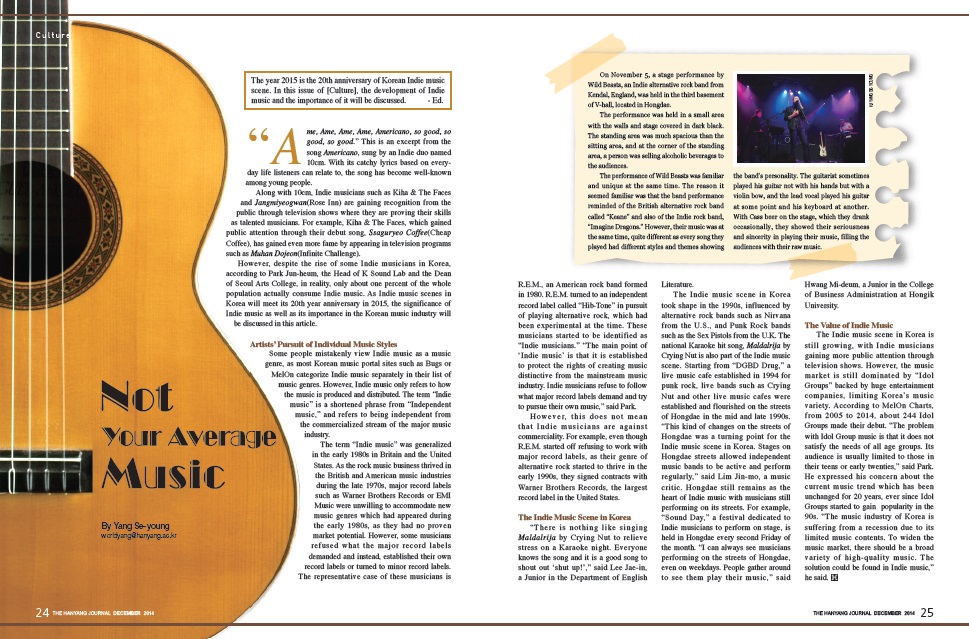
Along with 10cm, Indie musicians such as Kiha & The Faces and Jangmiyeogwan(Rose Inn) are gaining recognition from the public through television shows where they are proving their skills as talented musicians. For example, Kiha & The Faces, which gained public attention through their debut song, Ssaguryeo Coffee(Cheap Coffee), has gained even more fame by appearing in television programs such as Muhan Dojeon(Infinite Challenge).
However, despite the rise of some Indie musicians in Korea, according to Park Jun-heum, the Head of K Sound Lab and the Dean of Seoul Arts College, in reality, only about one percent of the whole population actually consume Indie music. As Indie music scenes in Korea will meet its 20th year anniversary in 2015, the significance of Indie music as well as its importance in the Korean music industry will be discussed in this article.
Artists’ Pursuit of Individual Music Styles
Some people mistakenly view Indie music as a music genre, as most Korean music portal sites such as Bugs or MelOn categorize Indie music separately in their list of music genres. However, Indie music only refers to how the music is produced and distributed. The term “Indie music” is a shortened phrase from “Independent music,” and refers to being independent from the commercialized stream of the major music industry.
The term “Indie music” was generalized in the early 1980s in Britain and the United States. As the rock music business thrived in the British and American music industries during the late 1970s, major record labels such as Warner Brothers Records or EMI Music were unwilling to accommodate new music genres which had appeared during the early 1980s, as they had no proven market potential. However, some musicians refused what the major record labels demanded and instead, established their own record labels or turned to minor record labels. The representative case of these musicians is R.E.M., an American rock band formed in 1980. R.E.M. turned to an independent record label called “Hib-Tone” in pursuit of playing alternative rock, which had been experimental at the time. These musicians started to be identified as “Indie musicians.” “The main point of ‘Indie music’ is that it is established to protect the rights of creating music distinctive from the mainstream music industry. Indie musicians refuse to follow what major record labels demand and try to pursue their own music,” said Park.
However, this does not mean that Indie musicians are against commerciality. For example, even though R.E.M. started off refusing to work with major record labels, as their genre of alternative rock started to thrive in the early 1990s, they signed contracts with Warner Brothers Records, the largest record label in the United States.
The Indie Music Scene in Korea
“There is nothing like singing Maldalrija by Crying Nut to relieve stress on a Karaoke night. Everyone knows the song and it is a good song to shout out ʻshut up!ʼ,” said Lee Jae-in, a Junior in the Department of English Literature.
The Indie music scene in Korea took shape in the 1990s, influenced by alternative rock bands such as Nirvana from the U.S., and Punk Rock bands such as the Sex Pistols from the U.K. The national Karaoke hit song, Maldalrija by Crying Nut is also part of the Indie music scene. Starting from “DGBD Drug,” a live music cafe established in 1994 for punk rock, live bands such as Crying Nut and other live music cafes were established and flourished on the streets of Hongdae in the mid and late 1990s. “This kind of changes on the streets of Hongdae was a turning point for the Indie music scene in Korea. Stages on Hongdae streets allowed independent music bands to be active and perform regularly,” said Lim Jin-mo, a music critic. Hongdae still remains as the heart of Indie music with musicians still performing on its streets. For example, “Sound Day,” a festival dedicated to Indie musicians to perform on stage, is held in Hongdae every second Friday of the month. “I can always see musicians performing on the streets of Hongdae, even on weekdays. People gather around to see them play their music,” said Hwang Mi-deum, a Junior in the College of Business Administration at Hongik University.
The Value of Indie Music
The Indie music scene in Korea is still growing, with Indie musicians gaining more public attention through television shows. However, the music market is still dominated by “Idol Groups” backed by huge entertainment companies, limiting Korea’s music variety. According to MelOn Charts, from 2005 to 2014, about 244 Idol Groups made their debut. “The problem with Idol Group music is that it does not satisfy the needs of all age groups. Its audience is usually limited to those in their teens or early twenties,” said Park. He expressed his concern about the current music trend which has been unchanged for 20 years, ever since Idol Groups started to gain popularity in the 90s. “The music industry of Korea is suffering from a recession due to its limited music contents. To widen the music market, there should be a broad variety of high-quality music. The solution could be found in Indie music,” he said.


